Flax - Kiwi Icon
For the first New Zealanders it was indispensible; used in clothing, shelter, for catching and storing food, and as medicine. In the early 1900s its fibre was one of our most important exports. These days flax endures as one of our most important plants, in the fine art of weaving, in our natural environment - and in our gardens.
The main difference between flax now and flax a hundred years ago is the explosion of different colours and forms, so unique and beautiful that they are sought after by gardeners all over the world. No other cold-hardy plant comes close to matching the look of flax with its unique combination of texture and shape.
In the wild there are two main species. Phormium tenax (harakeke or swamp flax) reaches two or three metres tall, its stiff upright leaves and flower spikes rising as high as five metres. This is the flax used in maori weaving. It is also the one to plant if you have wet ground or want to plant a shelter that doubles as a bird magnet. The towering flower spikes attract tui and other nectar seeking birds.
Phormium cookianum (wharariki or mountain flax)is shorter in stature with long twisted seed capsules. In the wild, two quite distinct forms of this species exist; one with weeping foliage, the other with stiff foliage. Phormium cookianum typically grows in coastal and mountain areas.
These native species have donated their genes to today’s countless modern cultivars. The main focus in recent times has been on increasing the range of colourful little flaxes suitable for our smaller gardens. Smaller flaxes also make fantastic container plants. With so many colourful varieties, it’s hard go past flax for year-round colour. Use it as an accent, for mass planting on difficult slopes, for large pots and in mixed shrub plantings to invite more birds into your garden.
Generally, the smaller cookianum types prefer well drained soil and are the most tolerant of dry conditions. They’re also best for windy sites. Tall Phormium texax can suffer from shredded leaves in heavy wind. On the other hand, it is useful for soaking up excess moisture, including fluid from septic tanks.
For small gardens in need of a plain green flax, Phormium cookianum 'Green Dwarf' is superb. Just 75cm tall, it has stiff upright foliage and beautiful yellow flowers, great for picking.
Making the most of flax
- For best colour and healthy compact growth, plant in full sun.
- Most of the low growing, colourful flaxes prefer well drained soils.
- Avoid very sheltered locations to minimize pests such as scale insect and mealy bug. An insecticide mixed with spraying oil is an effective control for these pests. Mixing in detergent or spray fixing agent will help it stick. Alternatively remove pests with a soft brush and soapy water.
- Most flax varieties are fairly frost hardy. If they are damaged by frost, refrain from removing the burned outer leaves until the risk of frost has passed.
- Water young plants in dry spells and feed in spring with slow release fertiliser.
- To keep flax tidy, cut old foliage cleanly from the base with a sharp knife. Plain green growth appearing on coloured varieties should be removed before it takes over.
- Lift and divide every few years to keep flax plants looking fresh.
How to lift and divide flax
Spring is a good time to rejuvenate flax plants and propagate more plants for your garden by lifting and dividing. Ideally it is done every few years. You’ll need a strong spade, a good sharp knife and bit of brute strength. First dig up the entire plant. Then divide it into sections, each with some roots and a fan of foliage. Don’t worry if you break some roots. They’re very tough. Trim long or damaged roots and trim the foliage by about half to make a fan shape. Replant into good, compost enriched soil and water well.
14-Sep-2014
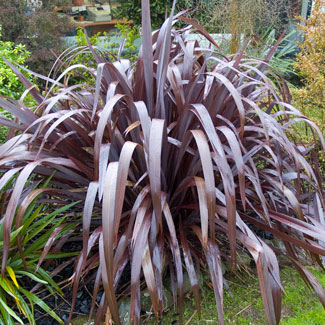
Phormium Dark Delight
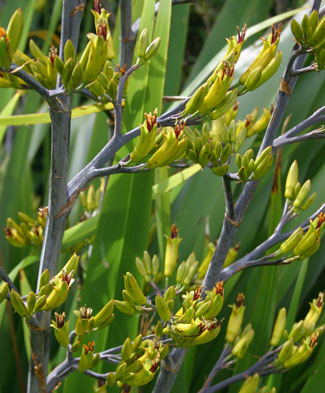
Phormium Green Dwarf flowers
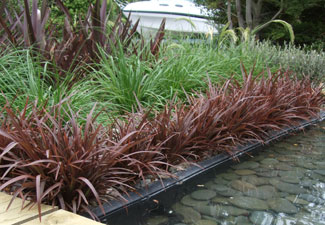
Phormium Sweet Mist
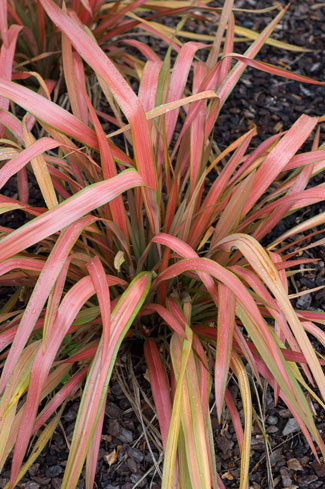
Phormium Jester
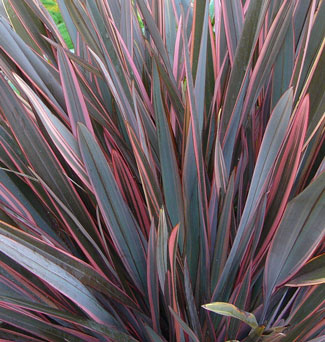
Phormium Rainbow Chief

